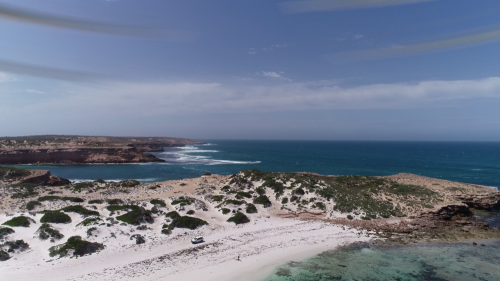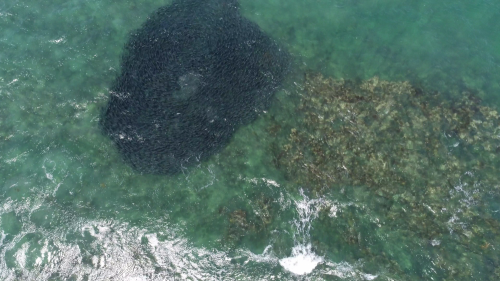Where
Fowlers Bay sits in the Great Australian Bight, immediately adjacent to the Great Australian Bight Marine Park. The bay is characterised by long stretches of wide, white sandy beaches and rocky headlands. To the east, they’re backed by towering sand dunes and to the west, immense 90 metre cliffs run for a 170 kilometre stretch. Exposed to south-easterly winds that drive large swells, the region is a popular haunt for the keen surfer and recreational fisherman. It is also known for its white shark population and thought to be prime habitat for juvenile white sharks.
Who
Russell Bradford & Toby Patterson (CSIRO Oceans & Atmosphere), Dirk Holman (DEW, SA), Paul Rogers (SARDI)
When
November-January 2019/20
Why
The Great Australian Bight provides a home for a wide range of marine species, many of which feed and breed throughout the region during different stages of their lives. The iconic, wide-ranging white shark (Carcharodon carcharias) is one such species that is known to use these waters, including those within the Nuyts Archipelago and Great Australian Bight marine parks.
As a top-order predator, white sharks play a vital role in marine ecosystems, helping to keep other marine populations in balance. White sharks in this area are from the southern-western Australian population (Australia has two populations of white shark, separated by Bass Strait).
In 2018, the CSIRO provided the first abundance estimate of the adult cohort of the southern-western population. However, more information about the juvenile life stage (less than 3metres in length) is needed before an estimate of the total population can be provided. Anecdotal reports suggest juveniles seasonally use near-shore environments around Fowlers Bay: to investigate this theory further, drone surveys were undertaken.
The data collected will contribute to our understanding of this white shark population and how they’re using the GAB region (Figure 1).

How
The surveys were undertaken with the assistance of the Yalata land management team. The drone was pre-programmed to undertake the survey flights over previously identified sites: the drone flew 40 metres above sea level at a speed of less than 4 metres per second (Figure 2).
A camera affixed to the drone recorded video footage for the entirety of each flight. At this height and speed, animals are clearly visible when flying over sandy seafloor habitats in relatively shallow depths. A similar technique has been used in New South Wales around the Port Stephens area to survey juvenile white shark habitat. In addition, free-form flights were undertaken over areas with more complex seafloor bathymetry, including at Scott Beach and Mexican Hat.
A total of 34 flights have been completed to date (as of January 2020), covering approximately 7.5 km2. The video footage from each flight was independently viewed by the team to identify marine animals, with a focus on identifying juvenile white sharks.
What did we learn?
A diverse range of marine life was identified from the survey footage including Australian sea lions (Neophoca cinerea) (Figure 3), little penguins (Eudyptula minor), Australian salmon (Arripis truttaceus) (Figure 4), eagle rays (Myliobatis australis), smooth rays (Dasyatis brevicaudata) and numerous species of shorebirds. From a marine park management perspective, data like this helps us better understand which animals are using Australian Marine Parks.
To date, no white sharks have been observed in the recorded footage, but what would it mean if juvenile white sharks are found in this area? It would indicate that pupping may also be occurring locally and that would be an exciting development. Researchers have been unable to identify pupping areas for this southern-western population. Further, if this area is a pupping ground then it is also likely that large, mature females are present.

What next?
This work has contributed to our understanding of the diversity of marine life using the Head of the Bight waters and the role marine parks may be having in protecting pelagic species like the white shark. Future studies would benefit from coupling aerial surveys with targeted Baited Remote Underwater Video deployments.
Further benefits would be gained from broadening the study area as this project only considered a tiny portion of potential white shark habitat in the region. Expanding the surveys to include the neighbouring Nuyts Reef complex, the St Francis Group of islands to the south-east, and Israelite Bay to the south-west, would further improve our understanding of how the iconic white shark is using marine parks such as the Great Australian Bight Marine Park. Population data, particularly for apex predator species, is critical to Australian Marine Park management.
Publications
This research is supported by the National Environmental Science Program Marine Biodiversity Hub, the CSIRO, and Parks Australia.

